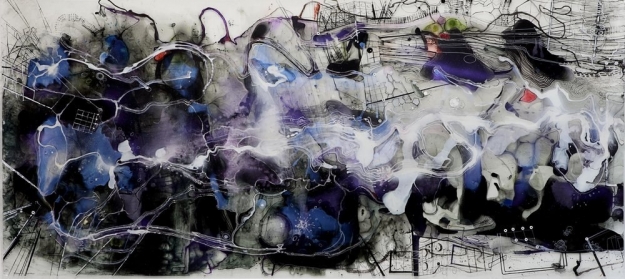Expulsions of Eve
Ieva Martinaitytė-Mediodia (b. 1968) will not allow the viewer to enjoy paintings peacefully. Existential anxiety subsists in her artwork. This anxiety is not only about human (non-)being, but also about that of the world. Her close to abstract works create the impression that ecological catastrophes, global warming and another world war are more than a mere fantasy. This may be the result of the artist balancing between the abstract and the figurative art. To be more exact, even abstract images in her works pose a strange scurf of physical matter and allusions to fluid substances. Her paintings affect both the viewer’s sight and their guts (that feeling when your body winces at the sight of injured people). At the same time, Martinaitytė–Mediodia’s art is aesthetic, translucent and icy. The viewer may glide along its surface and enjoy it until the black hole sucks her in.
UždarytiLet us start from the very beginning. Martinaitytė-Mediodia is one of the students who took classes with visiting US professor KęstutisZapkus in 1992–1993. Zapkus encouraged his students to delve deep into what they care most about and write a creative diary. It was not the style of the teacher, but the treasures of global culture that inspired the group of young artists called Good Evils. After graduating from Vilnius Academy of Arts, some of them –Aidas Bareikis, Julius Ludavičius and Ieva Martinaitytė–Mediodia –continued their studies at Hunter College in New York. Later exhibitions in Lithuania and all over the world followed.
Plasmatic Detritus is a large scale work, a portrait of an exploded star created on special paper and in acrylic paint. It could just as well be a landscape of numerous electric discharges with an accompanying fluctuation of magnetic field and a stream of cosmic particles. The dynamics of the painting are so intensive that viewers find themselves taken to the period when the primitive matter was formed or facing the moment of its death. Most likely to both: something dies and the plasmatic detritus becomes the node of a new structure. The work has been woven out of associative forms: cable networks, virtual space, views of cities from a plane and a cobweb of blood vessels. The interesting thing is that it seems as if Plasmatic Detritus is being inspected both from high above, as if trying to take a look from a greater distance, and from very close up, as if through a microscope lens all at the same time. The mix of the two different points of view in one painting creates the effect of cosmic vertigo. Even more interesting is that the dizziness appears not only because of optic, but also because of the style of painting, the way paint is spread, the dripping and viscosity further strengthen the impression of a rapidly wafting flow.
‘When I start painting and drawing, I want the canvas area to be like a movie, to make it look as if everything is moving, rotating, breathing. And it is quite difficult to do it in two dimensions. Everything you see in my works is like a map of my consciousness’
The artist is interested in the ephemeral and virtual extensions of a human being: robots, the internet and cosmic probes. Physical and virtual, earthly and the beyond worlds melt into each another. The artist uses different types of media and techniques to strengthen the impression of perpetual movement, animation and even cosmic effect. ‘When I start painting and drawing, I want the canvas area to be like a movie, to make it look as if everything is moving, rotating, breathing. And it is quite difficult to do it in two dimensions. Everything you see in my works is like a map of my consciousness,’says the artist.
Martinaitytė-Mediodia’s maps of consciousness are also maps of the changes taking place in Lithuania. It all started with the wounded Eve from The Garden of Earthly Delights by Hieronymus Bosch in the young artist’s early paintings. By now all the blood and wounds have been replaced with the breadth of the humming cosmic space with a multitude of connected consumers’souls. A physical hell turned into a virtual one, but the genuine anxiety remained. Martinaitytė-Mediodia’s creative path is a contemplation of both physical and metaphysical expulsion: expulsion from Heaven, Lithuania, America or the Earth. When we get expelled from Hell, we will become plasmatic detritus in the cosmic landscape of Ieva.


